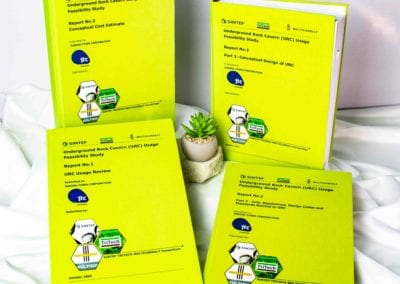
Tritech, together with a joint venture partner, Black & Veatch (SEA) Pte Ltd (B&V+Tritech JV) was directly appointed by PUB to conduct the study.
This study’s main objective is to explore the feasibility of an underground drainage system to mitigate the impact of floods due to climate change and extreme rainfall events. The Underground Drainage and Reservoir System (UDRS) is intended to be an integrated system comprising stormwater tunnels and detection storage, reservoir storage for water supply, and the possibility of a pumped-storage hydropower system.
The study’s scope includes worldwide literature review, geological studies and evaluation, technical feasibility & conceptual design of UDRS, cost estimates, cost-benefit analysis, construction method and timeline, land requirements and economic life cycle analysis, optimised UDRS and operating framework, etc.
The project incorporates a lot of environment-friendly and long term sustainable “Green” concepts.
This 24-month feasibility study thus consists of three main components: Stormwater Tunnel System (STS), Underground Reservoir Caverns (URC) and Pumped Storage Hydropower (PSH).
OVERALL CONCEPTUAL DESIGN OF THE UNDERGROUND DRAINAGE RESERVOIR SYSTEM (UDRS)
The three main objectives for the Underground Drainage and Reservoir System (UDRS) are as follows:
■ Stormwater Management. To mitigate the impact of floods due to climate change and extreme rainfall events of up to a 100-year return period.
■ Water Supply. To provide an underground reservoir storage for water supply purposes.
■ Pumped Storage Hydropower. To provide electricity storage on a large scale basis as a source of power generation as well as to balance reserves to smoothen the output of intermittent generation sources such as solar generators.
The overall concept and operation envisaged for the UDRS as an integrated system comprising of stormwater tunnels and detention storage, reservoir storage for water supply as well as the possibility of a pumped storage hydropower system.
For the Stormwater Tunnel System (STS), three options have been explored:
Centralised STS Network, where it is proposed for all STS tunnels to lead to a centrally located URC.
■ Decentralised STS Network, where it is proposed not to have a URC and for all STS tunnels to lead to decentralised coastal pumping stations.
■ Hybrid STS Network, where it is proposed for STS tunnels serving central water catchments to lead to a centrally located URC and to have separate decentralised tunnels serving outer non-water catchments to lead to coastal pumping stations.
For the Underground Reservoir Caverns (URC), two options have been explored:
■ One URC location with three levels of caverns at MacRitchie, where all three functions of stormwater management, water supply storage and pumped storage hydropower are co located at a single location.
■ Two URCs locations, with a single level caverns at MacRitchie and a two level caverns at Upper Peirce, where MacRitchie URC will primarily be for stormwater management and Upper Peirce URC will be for long term water supply storage and pumped storage hydropower. For the Pumped Storage Hydropower (PSH), two capacities have been explored:
■ Minimum Capacity, where PSH is able to generate at least 2500 MWhr / day of electricity.
■ Maximum Capacity, where after taking into account the URC volume required for stormwater management 50% of the rest of the available caverns volume is to be used for PSH for electricity generation.
Service:
Concept and Feasibility Studies
Underground Infrastructure and Space Utilisation




